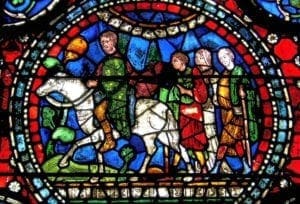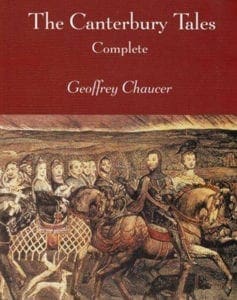Time, Stephen Hawking and ‘The Canterbury Tales’
By DAVID A. KING, PH.D., Commentary | Published March 23, 2018

Stained glass window of Canterbury pilgrims.
This morning, a particularly lovely early spring morning contrary to the prognostication of the groundhog, I became suddenly and profoundly aware of the passage of time.
As I made my daily patrol around my front and back yards, collecting the remains of yesterday’s outdoor play, I stopped assessing the damage to my shrubbery, my rapidly eroding bank of English ivy and the sandlot my front lawn is becoming. And I thought: all of this is passing. My sons’ childhoods are passing, and I’m worried about picking up toy dump trucks and baseballs and Nerf guns and bicycles.
Perhaps my epiphany had something to do with physicist Stephen Hawking’s recent death. Maybe it was spring fever. Yet I resolved for a moment not to worry about the mess the neighborhood children have made of my yard, and I tried to think of other things.
They’re a merry little band, the assorted ragamuffins and urchins and cherubs who roam our historic Marietta neighborhood. Most of them are between the ages of 5 and 10, and as the Jesuits say, in a child of 7, you can see the adult who is to come.
I can spot the future high school cheerleader, the only girl in the group whom all the little boys ignore—for now. I see the future mechanic. One was born to be a plumber, so fascinated is he with my garden hoses. Another has music in him. Still another is a born athlete. And there is probably at least one poet or professor or engineer or attorney among them. There might even be a priest. Time will tell. And it will tell soon.
Will they be defined by who they become, these children? Will their occupations, or vocations, make them who they really are? In one sense, I suppose they will, but in another I know that they are already who they will be, for as famed writer Geoffrey Chaucer knew, human beings are not defined by what they do; their unique nature determines who they truly are.
It’s hard not to think of Chaucer on a day such as this, particularly as we approach April, the month in which his masterful work, “The Canterbury Tales,” takes place. Yet thinking about time, and its relativity, makes it impossible not to think also of Hawking.
In one of Hawking’s obituaries, the scientist was quoted as having said, “We are just an advanced breed of monkeys on a minor planet of a very average star. But we can understand the universe. That makes us something very special.”
Advanced monkeys? The children in my yard, the people we encounter every day, the pilgrims in Chaucer’s Canterbury Tales? I’m no fundamentalist; I’m an educated man who puts a good deal of stock in both science and theology, and I’m open to the possibility—as is the Church—that all of nature, humans included, may evolve over time. But I can’t see myself as a monkey, even a special monkey.
Hawking professed no belief in God as Catholics understand Him. Frequently referring to himself as an atheist, Hawking also often acknowledged the possibility that there might be an “impersonal creator.” However compelling his theories about the universe, there was more Chaucer in Hawking than he might have known.
Chaucer’s key philosophy, an idea central to the understanding of the medieval mind, is that human beings should live wholeheartedly in the world while remaining spiritually detached from it.
When a society lives under constant threat of death from plague, invasion or even spoiled food, it has to adapt by enjoying itself while it can. We too often think of Chaucer’s Middle Ages as “the Dark Ages.” It is actually more accurate to describe the medieval world as an age of faith, a time when people clearly understood their lives in a theological context. Chaucer understood the human as a creature made with purpose. The human was meant to love and serve God in this world, both in the church and by delighting while he could in the joyful and beautiful aspects of creation that could never be completely dimmed by the troubles of the times.
Thus it is that Chaucer’s people delight in life, search for meaning in vocation and acknowledge God’s world and their place in it through religious practice and devotion.
For Chaucer’s age, the pilgrimage was a primary means of worship that also served the practical purpose of communion with one’s fellows and the development of a wider view of society. And Chaucer knew medieval society.
As a court clerk in Norman-occupied England, Chaucer had a foot in the worlds of both the aristocracy and the ordinary. As for his ears, one learned the French of the conquestor, while the other delighted in the changing English of his countrymen, a language that Chaucer actually helped preserve and transform through text.
 “The Canterbury Tales” was supposed to be a long work. Modeled after the Italian cycles of stories—such as Boccaccio’s “The Decameron”—which were popular at the time, Chaucer initially conceived of the approximately 30 pilgrims telling four stories each: two on the way to St. Thomas Becket’s shrine at Canterbury, and two on the way back. In the end, Chaucer only completed 24 tales. While we don’t know for certain the order in which Chaucer intended the tales to be structured, we do know that the “unfinished” work has a fairly cohesive structure in which the stories often seem to complement or contrast ironically with the others.
“The Canterbury Tales” was supposed to be a long work. Modeled after the Italian cycles of stories—such as Boccaccio’s “The Decameron”—which were popular at the time, Chaucer initially conceived of the approximately 30 pilgrims telling four stories each: two on the way to St. Thomas Becket’s shrine at Canterbury, and two on the way back. In the end, Chaucer only completed 24 tales. While we don’t know for certain the order in which Chaucer intended the tales to be structured, we do know that the “unfinished” work has a fairly cohesive structure in which the stories often seem to complement or contrast ironically with the others.
Much about the teller of each tale is revealed in the prologue that precedes his or her story, but the best picture of medieval life as a whole is given in the General Prologue, which opens the work. It is in the General Prologue that Chaucer reveals his brilliant and detailed understanding of human nature and personality. Chaucer makes clear from the beginning that we are travelling with real people, people all associated with a particular vocation but not at all defined by that vocation.
What an assortment of people they are, as varied and delightful and confounding as the children who trample my lawn. There is a knight, chivalrous indeed, but also meek and gentle. There is a prioress of an abbey, who seems to worry over table manners more than anything else. There is a monk, a wonderful man, who loves hunting far more than work or study. Among the many clergy and religious, there is a friar, irresistible and impetuous, who loves pubs and taverns. There is an Oxford student, more pious than most of the religious on the pilgrimage. There is a lawyer, described in one of my favorite lines as a “man who seemed busier than he was.” The trades are represented by a wealth of guildsmen, everything from a haberdasher to a carpenter. There is a doctor, and a sailor, a plowman and a parson, the latter two who are among the most genuine in the company. And there are rascals, lots of rascals, including a reeve, a summoner, a pardoner and a miller. These lowly men are among the shrewdest in the company, full of faults but also keenly insightful as to the foibles of human nature. Among the rest is the character who is the favorite of many readers, the wily Wife of Bath, who has had five husbands.
The tales that all the pilgrims tell demonstrate many things about their complex characters, but the General Prologue actually reveals more because of the vivid detail Chaucer provides about each person. The most interesting aspect of them all is that while they all possess the typical characteristics associated with their occupations in the world, they are also endowed with traits that distinguish them as individuals rather than mere caricatures.
As for the 24 tales they tell, they represent a tapestry of medieval literary genres, and many remain absolutely delightful. My students, over 600 years removed from the composition of the tales, marvel at the universality of the stories. After 26 years of college teaching, it is still a joy to introduce young people to the tales of the Miller, the Nun’s Priest, and the Wife of Bath.
Most of the stories contain lessons but without being didactic. We learn the danger of jealousy. We are warned about false piety. We discover what women most desire. And, my personal favorite, we learn. “May God greet with mischief the man who babbles when to hold his tongue were needful.”
Going back over the yard, I know that one day my boys and their friends will read these tales long after their childhoods have ended. I know that they, too, will delight in learning that human beings never really change; the human problems and predicaments of today are the same faced by Chaucer’s medieval pilgrims.
I am sorry that for as much as Stephen Hawking taught us about time and space, he didn’t spend more effort on what Faulkner called “the human heart in conflict with itself.” Though Hawking valued the human intellect and imagination, he primarily rendered it in abstract—though fascinating—theory. For me, “The Canterbury Tales” reveal more about humanity’s purpose and potential, while affirming the reality of God and the lives of his children at play in his universe.
David A. King, Ph.D., is associate professor of English and Film Studies at Kennesaw State University and director of adult education at Holy Spirit Church in Atlanta.